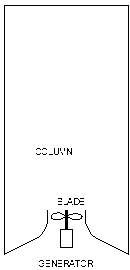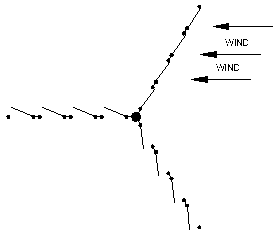Wind
Don’t be fooled: The utility
companies (and even some enviro-politicians) do not want
individuals messing with alternative energy. In the early seventies
when America was suddenly shocked by escalating oil prices, major
power companies were concerned that the flurry of alternative energy
activity might erode their control. Power is power. Their pretense of
interest in alternative energy is only real to the degree that they
can maintain control. The rest of their rhetoric is – well, wind.
During this period a major energy
supplier actually tried to patent the concept of capturing energy
from the sun.
I knew of an innovator in my town
of residence in Colorado that built his own power system and went
off the grid. He was heavily fined and harassed and eventually
compelled to reconnect! Granted, this was before such things became
the new American dream, but even today radical and practical
solutions are a dangerous no-no.
I managed to bootleg an illegal
woodstove into a modest modern house near Colorado Springs and
remember paying – I believe it was $27 – one month for our gas
bill, while neighbors on either side in similar houses paid well
over $100 the same month. We received a brochure from the utility
company warning of the heat that is wasted and of the economic
impracticality of fireplaces. Our more compliant neighbors received
no such notices.
I learned of a school district
that was recently considering major solar-electric installations for
all new construction. When the utility company learned of it they
offered them a 10% discount if they would drop such plans. The
school district complied.
One lonely teenage Christmas season
in Oklahoma, over a thousand miles from home I found junk from an
ancient telephone in an old shed. I somehow managed to bolt an
automotive fan blade to the generator of this relic, and wired some
laths to the blades to extend their reach. I clamped the contraption
in a vice mounted on an old stump outside, and ran some wires into
the shed.
I had the simple nerdy pleasure of
watching significant sparks. I have no idea of what the voltage or
power was, but I was very impressed when I stupidly offered it a
finger. It was even more impressive when I connected it to an
unsuspecting friend.
Beyond such play I have never done
any wind-electric experiments, but that hasn’t kept me from
thinking. So I’ll dump a couple concepts for somebody else to try –
or not.
Consistent with
public-versus-private faces, it has been made extremely difficult to
build wind powered systems in towns. The ruling reads that you must
first calculate the maximum distance a windmill blade could be thrown
if it came off at maximum speed as it was spinning in an upward
portion of the arc. This distance must then be the minimum distance
to the property line nearest your windmill. Most city lots are not
that big, and I doubt if even decorative plastic garden ornaments
actually qualify.
In contemplating this obstacle, I
envisioned a vertical column covered with light-weight flaps that
would open with the vacuum caused by passing wind. If you mounted a
much smaller fan in a venturi built into its base, the neighbors
would be quite safe from any potential mishap, and if you called it a
silo you might even be safe from the energy police.
While contemplating light-weight
flaps, consider a vertical axis turbine with flaps that would catch
the wind on one arm while releasing it on the other. This too would
be an omni-directional system.
image012.gi /image013.gi


Both these systems, being vertical
axis, and omni-directional, are much simpler mechanically than
conventional pole-mounted windmills. The electrical wiring doesn’t
have to keep up with changing wind directions, and all the generator
servicing takes place at ground level.
Given the fickle nature of wind, I
personally would relegate it to a status of “auxiliary power.” In
a site where wind is fairly consistent, it could be a significant
contributor to the over-all energy package.
One technical detail I should toss
in here for those truly interested is the fact that the energy
available in wind increases with the cube of its velocity.


